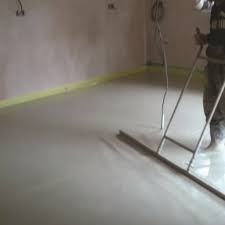Screed is a combination of cement and sand, resembling a dense paste. It has a high viscosity and can be used to level irregular surfaces on your home’s foundation before you apply your luxury vinyl tiles. Screeding is essential because it forms a solid foundation that will support the weight of your residence evenly across its surface, preventing any parts from drooping. The process also eliminates air pockets which could cause cracks in the finished exterior coating of your flooring material.
Our Pro Tiling Melbourne team offers Tile Screeding and luxury vinyl flooring, as it is essential that the flooring is prepared in the right way. If you have any questions or queries, be sure to get in touch with our team today, we are always happy to help in any way we can.
Call 0450 516 537
The materials required to make tile screed are; sharp sand, cement, and water. By mixing these, you will get a screed. Our team can make the right mixture of screed for your flooring and ensure its perfect consistency. The most common mix of screed is a ratio of 1:4, with the mixing process being the crucial part of the process. If the screed is not mixed correctly, it will be lumpy and messy. You can do this with a screed pump; a specialist tool will combine the perfect batch and fail if it is not done correctly. You can use a cement mixer; the only way to get the best out of the screed you use is to make sure you make it correctly. The best option is to hire a professional team to come, make and lay your screed. This takes away the risk of doing it wrong. When you use a professional, they will also have access to the right equipment, such as a screed pump; this will help minimise the risk of underfloor heating pipes.
Choosing a business with the technical knowledge and skills to offer your screed that is made perfectly, smooth, and flat is essential; our team at Pro Tiling Melbourne is the right team for you.

Minimum fall requirements are mandatory for wet areas to manage surface drainage and lessen the effects of wind-driven rain. Bonded and unbonded mortar screeds are often used in conjunction with a suitable waterproofing membrane system to manage surface drainage or act as a ballasted drainage cell. The simple screed is often misunderstood, though, and when partnered with the wrong waterproofing system, it results in systemic failure and breach of BCA performance provisions.
AS 3740-2010 3.2 says that the waterproof membrane should be installed above or below the tile bed or screed where they are used. Both are valid and have various uses. For instance, membrane application beneath the screed is common in Melbourne as a transition from formed external metal trays and flashing. But, what are the pitfalls, and how do we decide which system to adopt?
We first assess the area to be waterproofed and the membrane system used to specify the appropriate design. This is often approached witha thought to the serviceability of the waterproofing system, which often results in membrane failure. It can cause adverse collateral defects such as efflorescence and bacterial growth in the bed. Service factors include:
Below tile screed application is applicable where extensive substrate movement or construction joints are present, requiring an unbonded sheet membrane such as PVC or torched bitumen. An unbonded screed is placed over the membrane as ballast and porous drainage cell. Below screed application may not be appropriate in a disabled open shower bathroom, where the screed becomes coagulated with organic matter resulting in bacterial growths and restricted screed drainage.
Above screed membrane application is appropriate where a bonded membrane is applied onto a bonded screed with mandated bond breakers and release zones; maximising control of falls and movement accommodation of the membrane. However, this is not appropriate where a solvent-based polyurethane membrane is applied, not being compatible with tile adhesives and other finishes.
Render, bed, screeds are an important part of waterproofing systems. Misused and mismatched with the wrong Tile Screed can result in systemic failure. Unbonded screeds are best layed as a floating bed, over unbonded membranes, where bonding to solvent or sheet membranes is not possible, or where structural movement dictates unbonded systems with isolation layers.
If you want to lay a Screed bed or need Tile Screeding services, contact the experts of Pro Tiling Melbourne. We will be happy to help you out whenever you need us.
Call 0450 516 537